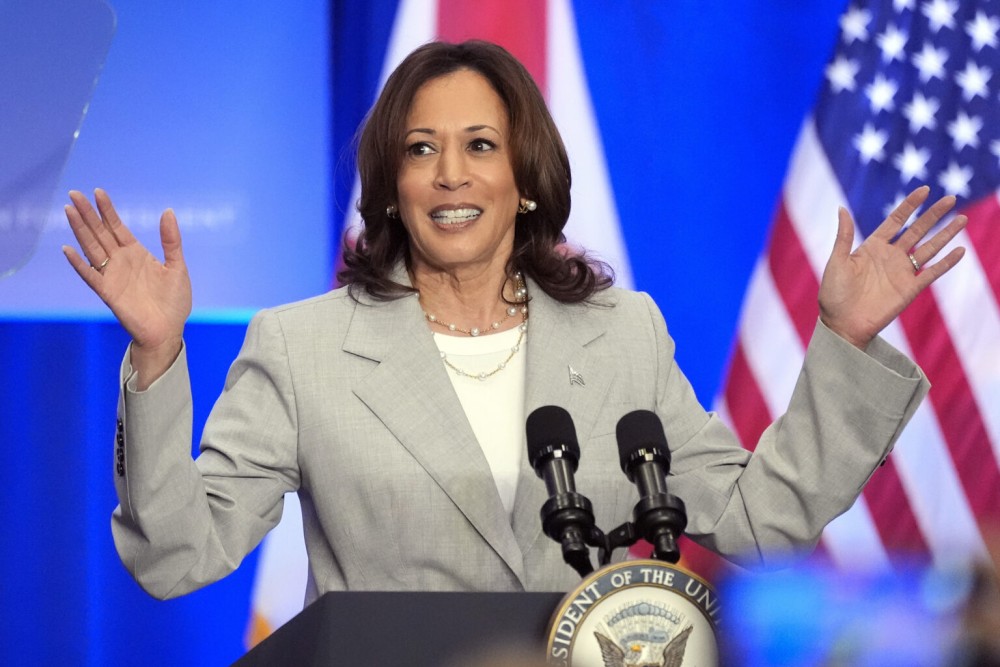Kamala Harris’s multi-religious identity is a map of the future

Vice President Kamala Harris speaks at an event May 1 in Jacksonville, Florida. (AP Photo/John Raoux, File)
President Joe Biden made history on Sunday by withdrawing his candidacy for a second term. The reconfigured Democratic presidential ticket he endorsed, with Vice President Kamala Harris at the top, would be historic. It would also be a map of the United States’s future.
Harris has a diverse personal religious and spiritual history that is now far more representative of America’s multifaith makeup. Raised Hindu by her mother, Shyamala Gopalan, a native of Chennai, India, as children she and her sister, Maya, were often taken to 23rd Avenue Church of God in Oakland, California, by their neighbor Regina Shelton. As an adult, Harris joined a Black Baptist church—Third Baptist Church of San Francisco, led by Amos Brown.
Meanwhile, the man who would become Harris’s husband, Los Angeles lawyer Douglas Emhoff, grew up in New Jersey attending a Reform synagogue.
Harris’s faith connections have frequently played themselves out in the past four years. The Second Couple inaugurated a tradition of lighting Hanukkah candles at their residence, as well as celebrating Diwali, the Hindu festival of lights.
Every past US president has identified as Christian, and that will not change if Harris is elected in November. But as she runs for president, her religious biography will not only be history-making but will also connect her to the ways many people in the US practice and encounter faith.
“She represents a lot of Americans’ religious story, because here’s the thing: Nobody grows up in a straight line with religion in America anymore,” said Anthea Butler, a professor of religion at the University of Pennsylvania.
Few younger Americans, Butler said, have only one religious lineage that they carry on from their parents. Increasingly, people in the US choose a different religious identity for themselves and may change course again as they intermarry and interact with, and support, a partner of a different faith.
Indeed, Emhoff’s own daughter, Ella, one of two children from his previous marriage, has made it clear that she is not Jewish, in keeping with the trend toward children chooosing their own religious and spiritual path.
Brian Pennington, director of the Center for the Study of Religion, Culture and Society at Elon University in North Carolina and an expert on South Asian religion, said students in his courses who come from one religious tradition are becoming rare. “These days, they have multiple influences that inform their spiritual ideas and identities,” said Pennington.
This dynamic is present in Republican Party vice presidential nominee J. D. Vance, a Protestant turned atheist who married a Hindu woman before converting to Catholicism in 2019. At the Republican National Convention, Usha Vance spoke of how her husband adapted to her family’s vegetarian diet. He spoke of how she has made his Catholic faith stronger.
But while prominent Republicans are wary of diversity as a goal in its own right—some have already used the term “DEI candidate” to describe Harris—the vice president has shown that her personal experience gives her credibility and ease when navigating various religious traditions.
“She speaks about these multiple influences so comfortably and seamlessly, as if they’re all just part of her story that informs who she is,” said Pennington, who added, “It’s not at all hard to imagine that [Harris’s] personal religious and spiritual history would speak to younger Americans, who demographically have much more experience of this kind of religious diversity in their families and backgrounds than older Americans.”
Already some White supremacists and Christian nationalists have denigrated Vance and his wife for their mixed marriage, and Harris’s complex religious identity may also invite attacks. But according to Eboo Patel, founder and president of Interfaith America, the two couples offer, in their own ways, what may be an ascendant view of interfaith marriage.
“It’s a positive diversity story for America, for people from different religious backgrounds to be married to each other and to say, my experience with the other person’s faith strengthens my own and makes me a better person,” Patel said.
That slice of the US religious scene is growing. Almost two in five Americans (39 percent) who have married since 2010 have a spouse who is in a different religious group, according to a 2015 Pew Research survey. Pew also found that 20 percent of marriages in the US were interracial, up from 3 percent in 1967.
Patel said Emhoff was the keynote speaker for Interfaith America’s Black Interfaith project and, as first gentleman, would likely continue in that role as a spokesman for interfaith causes. He also has used his position to speak out against antisemitism.
In 2021, Harris and Emhoff, who met on a blind date in 2013, nailed a mezuzah to their front doorpost at their residence, on the grounds of the United States Naval Observatory, where they also hosted Rosh Hashanah gatherings, as well as a Passover Seder.
“I think it’s an important thing that is on display on the national stage in this way,” said Patel. “It is a display of diversity being an American treasure, and it’s a display of identity being a source of pride and a display of faith being a bridge of cooperation. I think that those are all very important.” —Religion News Service





